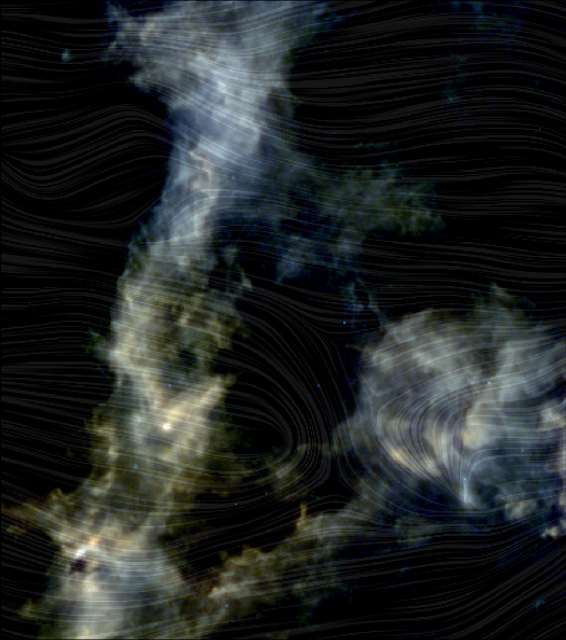
ESA - Herschel Mission patch / ESA - Planck Mission patch.
July 6, 2020
Taurus Molecular Cloud viewed by Herschel and Planck
A collection of intriguing images based on data from ESA’s Herschel and Planck space telescopes show the influence of magnetic fields on the clouds of gas and dust where stars are forming.
Rho Ophiuchi cloud complex viewed by Herschel and Planck
The images are part of a study by astronomer Juan D. Soler of the Max Planck Institute for Astronomy in Heidelberg, Germany, who used data gathered during Planck’s all-sky observations and Herschel’s ‘Gould Belt Survey’. Both Herschel and Planck were instrumental in exploring the cool Universe, and shed light on the many complexities of the interstellar medium – the mix of gas and dust that fills the space between the stars in a galaxy. Both telescopes ended their operational lifetime in 2013, but new discoveries continue to be made from their treasure trove of data.
Lupus cloud complex viewed by Herschel and Planck
Herschel revealed in unprecedented detail the filaments of dense material in molecular clouds across our Milky Way galaxy, and their key role in the process of star formation. Filaments can fragment into clumps which eventually collapse into stars. The results from Herschel show a close link between filament structure and the presence of dense clumps.
Corona Australis molecular cloud viewed by Herschel and Planck
Herschel observed the sky in far-infrared and sub-millimetre wavelengths, and the data is seen in these images as a mixture of different colours, with light emitted by interstellar dust grains mixed within the gas. The texture of faint grey bands stretching across the images like a drapery pattern, is based on Planck’s measurements of the direction of the polarised light emitted by the dust and show the orientation of the magnetic field.
Chamaeleon I molecular cloud viewed by Herschel and Planck
The study explored several nearby molecular clouds all within 1500 light years from the Sun including Taurus, Ophiuchus, Lupus, Corona Australis, Chamaeleon-Musca, Aquila Rift, Perseus, and Orion.
Chamaeleon II molecular cloud viewed by Herschel and Planck
In this study, published last year in Astronomy & Astrophysics, the Herschel data were used to calculate the density of the molecular clouds along our line of sight to investigate how the interstellar medium interacts with surrounding magnetic fields.
The Musca molecular clouds viewed by Herschel and Planck
Astronomers have long thought magnetic fields play a role in star formation, along with other factors such as gas pressure, turbulence, and gravity. However, observations of the magnetic fields in and around nearby star-forming clouds have been limited until the advent of Planck.
The Aquila Rift star-forming complex viewed by Herschel and Planck
The paper builds upon previous studies by the Planck collaboration to investigate how interstellar matter is likely coupled to these magnetic field lines, moving along them until multiple ‘conveyor belts’ of matter converge to form an area of high density. This can be seen in some images in the form of ‘striations’, which is material that appears perpendicular to the filament. These regions continue to receive matter along the magnetic lines until they collapse under their own gravity, becoming cooler and dense enough to create stellar newborns.
The Perseus molecular cloud viewed by Herschel and Planck
While the magnetic field is preferentially orientated perpendicular to the densest filaments, it appears that the orientation of the magnetic field changes from parallel to perpendicular with increasing density. However, there appears to be no correlation between the star formation rate and the orientation between filaments and magnetic fields, although the study also finds a correlation between the distribution of projected densities.
The Orion A molecular cloud viewed by Herschel and Planck
The Orion B molecular cloud viewed by Herschel and Planck
Related links:
Astronomy & Astrophysics: https://www.aanda.org/10.1051/0004-6361/201935779
Herschel: https://www.esa.int/Science_Exploration/Space_Science/Herschel
Herschel’s ‘Gould Belt Survey’: https://sci.esa.int/web/herschel/-/48623-herschel-unravels-the-thread-of-star-formation-in-the-gould-belt
Planck: https://www.esa.int/Science_Exploration/Space_Science/Planck
Planck’s all-sky observations: https://www.esa.int/ESA_Multimedia/Videos/2018/07/The_legacy_of_Planck
Images, Text, Credits: ESA/Herschel/Planck; J. D. Soler, MPIA.
Greetings, Orbiter.ch












